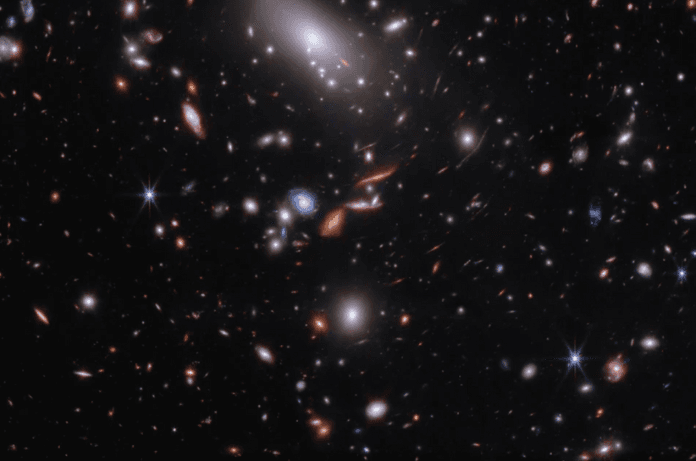Extraordinary images were obtained from NASA’s James Webb Space Telescope (JWST), these mesmerizing images reveal a galaxy glittering with ten distinct star clusters, each formed at different intervals, mirroring the developmental pattern of the Milky Way. In an awe-inspiring discovery, a team led by Wellesley College astronomers has captured these stunning images of a newly forming galaxy that offers a rare glimpse into the early stages of our own Milky Way. In the latest images captured by JWST, the new galaxy resembles fireflies dancing on a summer night, said researchers and this wonderful team of scientists have named this new galaxy “Firefly Sparkle Galaxy.”
These extraordinary images reveal a galaxy glittering with ten distinct star clusters, each formed at different intervals, mirroring the developmental pattern of the Milky Way. It is a cosmic wonder dating back to 600 million years after the Big Bang. Also, researchers say that this early snapshot of a forming galaxy helps us understand the origins of our own celestial home and challenges long-standing beliefs about galaxy formation in the early universe.
Firefly Sparkle: A Mirror of Our Milky Way’s Youth
The discovery is particularly significant because the mass of the Firefly Sparkle is comparable to what the Milky Way’s mass might have been at the same stage of its evolution. According to Professor Jeyhan Kartaltepe Mowla, a lead astronomer on the project, “These remarkable images give us an unprecedented picture of what our own galaxy might have looked like when it was being born.” By examining the Firefly Sparkle, astronomers can piece together how our galaxy took shape and evolved over billions of years.
Traditionally, it was believed that disk galaxies like the Milky Way formed later in the universe’s timeline. However, these new findings indicate that such galaxies were not only present but common in the early universe. The JWST has revolutionized our understanding, pushing back the formation of these structured galaxies to near the universe’s beginning.
Challenging Previous Beliefs About the Early Universe
Earlier observations made with the Hubble Space Telescope led astronomers to believe that disk galaxies were rare in the universe’s early stages. It was thought that the cosmos was dominated by irregular, chaotic galaxies formed through violent mergers. This view posited that stable, disk-shaped galaxies like the Milky Way didn’t emerge until the universe was around 6 billion years old.

Christopher Conselice, a professor of extragalactic astronomy at The University of Manchester, explained, “Using the Hubble Space Telescope, we thought that disk galaxies were almost non-existent until the universe was about 6 billion years old. These new JWST results push the time these Milky Way-like galaxies formed to almost the beginning of the universe.”
This discovery flips our understanding of galactic evolution on its head. Instead of being fragile and rare, disk galaxies appear to have been forming steadily and consistently throughout cosmic history.
What Makes the Firefly Sparkle Unique?
The Firefly Sparkle stands out due to its resemblance to the young Milky Way, showcasing multiple phases of star formation within a relatively small region. As Professor Mowla noted, “I didn’t think it would be possible to resolve a galaxy that existed so early in the universe into so many distinct components, let alone find that its mass is similar to our own galaxy’s when it was forming.”
The ability of the JWST to capture such detailed images of early galaxies marks a monumental leap forward for astronomy. With its infrared capabilities, JWST can peer through cosmic dust and reveal the true structures of galaxies that were previously hidden from view.
Disk Galaxies: More Common Than We Thought
This study also highlights that disk galaxies are ten times more common in the early universe than previously thought. These findings suggest that galaxies like the Milky Way were forming at an accelerated rate, much earlier than anticipated.
Leonardo Ferreira, the lead author from the University of Victoria, remarked, “For over 30 years, it was thought that disk galaxies were rare in the early universe due to violent encounters. The fact that JWST finds so many is another sign of the power of this instrument and that the structures of galaxies form earlier in the universe than anyone had anticipated.”
Myth and Reality: The Milky Way in Cultural Context
The Milky Way has always held a place of wonder in human culture. In Babylonian mythology, the Milky Way was believed to have been created from the severed tail of the saltwater dragoness Tiamat, set in the sky by Marduk after a cosmic battle. Meanwhile, in Greek mythology, the Milky Way was said to be formed by the spilled milk of Hera while nursing the infant Heracles.
This celestial band of light, named after the Latin term “via lactea”, meaning “milky way,” has been a source of stories and inspiration for millennia. Now, thanks to the JWST, we are uncovering the real origins of this stellar phenomenon, grounding mythology in the reality of cosmic evolution.
Implications for Future Research
These findings open the door to new questions about the universe’s rapid development and the role of dark matter in early galaxy formation. Understanding how galaxies like the Firefly Sparkle took shape will help scientists refine models of cosmic evolution and gain deeper insights into the forces shaping the universe.
As Professor Conselice summarized, “These JWST results show that disk galaxies like our own Milky Way are the most common type of galaxy in the universe. This changes our complete understanding of how galaxy formation occurs.”
Looking Ahead: A New Era of Discovery
The Firefly Sparkle is just the beginning. With the JWST offering unparalleled views of the cosmos, astronomers are poised to uncover more galaxies that will expand our understanding of the universe’s infancy. Each new discovery provides a piece of the puzzle, bringing us closer to understanding the grand tapestry of cosmic history.
As Professor Mowla said, “These images are the very first glimpse of something that we’ll be able to study and learn from for many years to come.”

